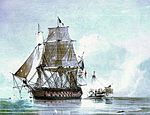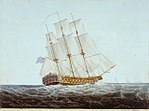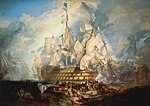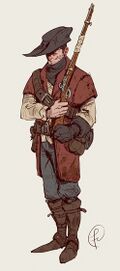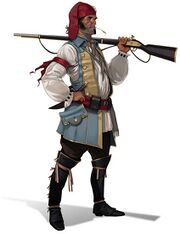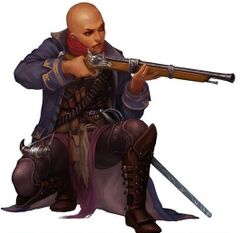Iblesian Armed Forces
The Royal Navy, also know internationally as the Iblesian Royal Navy, was established in 1222 by Alexander II of the Kingdom of Brytha. Initially the navy was established to end the reliance on levied civilian ships for defence in times of war; during engagements between Brythan and Gaelyan forces throughout the 11th and 12th centuries the Kingdom of Brytha had failed to make significant headway despite its numerical superiority, because many Gaelyan vessels were based upon more practical designs for military use and thus proved generally superior. The poor condition of the majority of the ship that trading companies provided for the levy, since they did not wish to risk losing their more valuable ships, also played a part in Brytha's poor naval performance. Alexander II formed the Royal Navy as a means to create a permanent naval force that could perform consistently and have dedicated military ships under its command, however it was Alexander III who really drove the formation of the Royal Navy as it is today.
When Alexander III assumed the throne by right of combat in 1224 he inherited a kingdom which was mired in a long term war with its northern neighbour Gaela. Efforts to push north overland had met moderate success under Alexander II, however the structure of Brytha's armies at the time, and their reliance upon heavily armoured cavalry made any advances into Gaela's territory difficult. Meanwhile the Brythan coastline was under constant threat from Gaelyan raiders and privateers who disrupted trade and severely damaged Brytha's coast infrastructure which weakened its position. What Brytha did have however was a much larger population and a much more developed economy. By establishing a naval shipyard at Fort Andrews on the southernmost inhabited isle within the Kingdom of Brytha, and securing the waters between it and the mainland, Alexander III was able to direct the construction of a new type of navy in safety. The first engagements this new navy would fight would not take place until 1266, partly due to a brief period of peace between 1236 and 1252, and partly down to Alexander III's insistence on slow and methodical building up of overwhelming force.
The Act of Union in 1606 following Alexander III's succession to the throne of Gaela by right of combat brought an end to the age of war between the two nations of the isles. The formation of the new Commonwealth of Iblesia with the Royal Grant in 1622 handed control of the navy to the elected government. By this time the navy had developed into a formidable force which was largely engaged in patrols and pirate hunting; the early adoption of cannon, which replaced the old Scorpions and catapults previously used meant that the 1622 fleet was one of the best equipped and most advanced in the region. Throughout the 1630s and 1640s the Royal Navy pioneered new methods of naval warfare so as to make best use of new ship designs which allowed for more gun decks, great speed, and greater durability. One of the largest factors which contributed to the technological advancement in the Royal Navy was their use of double hulls made from solid Iblesian Oak on the outside, and softer timbers on the inside so as to reduce shivering in increase resilience.
At present the Royal Navy fields 220 ships in active service which range from the small eighteen gun Victoria class Sloop-o-War, to the much larger Ships-of-the-Line which field as many as 120 guns. The majority of the Royal Navies chips as frigates which carry between forty and sixty guns, with only a handful of larger vessels exceeding this number of guns. The primary goal of the Royal Navy is to protect merchant shipping and facilitate the continued expansion of the Commonwealth, as such most ships are organised into squadrons of three to six ships of varying sizes, with each squadron having at least one 'runner' (basically any light vessel capable of rapid movement) so that should the squadron be overcome at least one ship may be able to escape. The Royal Navy rates its cannon by the weight of shot, and considers the 18 Pounder to be the lowest calibre for rated naval ordnance; larger calibres such as 24 Ponders and 32 Pounders are employed too, with the 32 Pounder being seen as standard for any heavy ship; smaller calibres are used as well on lighter vessels with the smallest gun in regular service being the 6 Pounder gun, however these are not considered to be rated guns.
The uniform of the Royal Navy is standardised across the entire fleet with even the lowest ranking seaman being issued a standard uniform. The navy's primary colour is red, with blue, white, and black as secondary colours. Thus a seaman is given a white shirt, black hat, red jacket, red sash, and dark blue trousers. Officers meanwhile are between dressed in red, blue, and white. An individual's rank aboard a Royal Navy ship is very much apparent by the quality of their uniform, with skilled seamen and ratings being issued finer clothing of a different, distinctive cut, to the regular sailors. Similarly gunnery crews are given different uniforms out of practicality which feature leather bracers, boots, and padded helmets.
Iblesian Rating System
The Iblesian Rating System is the system by which different ships are classified. The system original served only to provide a classification of Iblesian ships but over time has been adapted to rate enemy vessels too. The Iblesian system is based on the number of guns rated 18-Pounder or more in calibre that are positioned along the broadsides of the ship; bow and stern guns, deck mortars, and swivel-guns are not counted towards the rating of a ship. A full broadside will usually therefore only employ half the guns rated on the ship, a double broadside (when the guns are fired on both sides) will use all of them, and a stacked broadside occurs very rarely when guns are moved from one battery to the other to increase the firepower of a full broadside.
Royal Marines
The Royal Marines are the navy's infantry branch, their job is most often to guard naval facilities and ships while at anchor, however once at sea they also operate as enforcers of the Captain and officers' will. Marines are drawn from the middle classes and are well trained and well paid; this is done deliberately so as to ensure that they are separate from the crew and remain loyal to the officers in the event of a mutiny. Marines are also shown a considerably greater level of respect by their superiors than the seamen the serve alongside are and receive better rations. Compared to service in the Royal Army service as a marine is preferable for most recruits who come from a more affluent background because it requires less hard manual labour and comes with a greater social standing.
During combat marines make up the main defence force when attempting to repel boarders, and also serve as the unit leaders during boarding actions, with each marine being assigned a group of crewmen. This doctrine was put in place to ensure unit cohesion and a degree of order during boarding actions, and to ensure that a level of strategy can be employed effectively. To these ends marines are equipped with musketoons, short double barrelled flintlock muskets usually loaded with ball and buck, they also have a bayonet, however once it comes to close combat they are trained to switch to boarding swords (a type of basket hilted broadsword with a shorter blade) and pistols. This combination makes them quite versatile but also deadly in the close confines of shipboard combat. The standard tactic when boarding an enemy vessel is to rake the deck with canister shot from the deck guns, fire a volley of shot from their musketoons, and then advance, leaving their musketoons behind. On land the marines are intended to operate as defensive troops and light raid infantry when required. Their training allows them to move rapidly and fight in skirmish patterns and less conventional combat, however their equipment means that they will seldom hold up well on a full battlefield as line infantry.
Marine uniforms follow a similar pattern to those of the naval officers they serve. A red longcoat with blue or black edging over a white shirt and waistcoat, with either white or black trousers are standard. Unlike standard line infantry of the Army marines are also given a leather combat harness which has underarm holsters for their pistols as well as storage for extra powder and shot.
Royal Army
The Royal Army was established in 1606 shortly following the Act of Union and officially replaced the older system of personally raised regiments and royal yeomanry. The introduction of early muskets made more organised and disciplined formations of soldiers a necessity in order for the newly formed nation to effectively protect its borders and put down rebellions. The early Royal Army consisted largely of infantry and artillery, and employed the shot-and-pike tactics which had proven effective against native cavalry and light troops on the mainland of Mathaar. However as musket technology advanced the Royal Army chose to do away with the pike in favour of bayonets mounted on smoothbore muskets. The Royal Army continues to be centred around infantry and artillery, however it now employs light sabre cavalry, lancers, and mounted musketmen as well.
The Royal Army is a professional standing army which has a rigorous recruitment and training processes meant to weed out the weak, cowardly, and insubordinate. The result of their extensive training and the high regard in which they are held by both the government and common citizenry has given them the reputation of an elite fighting force. By far the bulk of the army's numbers are made up of Bluecoat Infantry, soldiers equipped with a smoothbore flintlock musket and bayonet who take their names from the light blue coats and uniforms they wear. Different regiments have their own variations of the uniform, with some feature long or great coats and others cavalry style tunics; the 1st Royal Household Infantry are famous for their dark blue hussar jackets. The basis of army strategy with the Bluecoat Infantry is centred around the 'brick'. Soldiers serve in a formation of thirty men led by an officer, this formation is known as a brick, the brick in turn acts as part of a larger formation made up of five bricks in total. This system allows the infantry for form in good order and discipline a firing line, or a number of alternate formations such as the box, as required.
Commissioned officers within the Royal Army are recruited from the gentry and aristocracy, this is because an officer is expected to pay for his own training, uniform, and equipment. Military training is often used as a means of employing the younger sons of noble families in an honourable profession. However the officers' training is as rigorous as that the regular soldiery must endure, and includes the more academic areas of study required of a commissioned officer. All commissioned officers are expected to be able to form up as a part of an ordinary soldier within a 'brick', and they are required to be as disciplined and capable in combat as their men. A particular emphasis is placed upon imparting the principle of 'Disdain for Mortal Danger' upon all officers so that it can be said that no common soldier will be expected to go where his officers dare not. Upon completion of their training a commissioned officer received a sabre and a flintlock pistol, they are expected to use both for the remainder of their military career; however in the field they are often issued the same primary armament as the unit they are in.
A newer innovation within the Royal Army is the use of rifled muskets; small scouting and skirmish infantry units have been established to take advantage of the increased range and accuracy of these weapons. However because the rifled musket is such a new innovation within the Royal Army and is largely untested number of such troops are minuscule.
The Royal Army relies heavily upon advanced weaponry and the synthesis of varying troops types and tactics. One of the most prominent examples of this is their extensive use of artillery, and their recognition of the value of good artillery crews and officers. To serve in an artillery regiment is viewed as a privilege and artillerymen see themselves as an elite cadre within the army. The most common piece of field artillery in present use is the 24-Pounder Long Gun, however lighter 12 and 9-Pounder guns are also in regular use, alongside mortars. Most artillery regiments are largely comprised of fusiliers, a form of heavy infantry who serve as a protecting force for the guns themselves; a typical fusilier is armed with a large bore double barrelled musket loaded with ball and buck, a bayonet, and a hatchet. Additionally fusiliers are trained in the rudiments of cannon operation in the event that one or more of the crew are wounded or killed. Occasionally fusiliers operate as mounted infantry, accompanying lighter horse artillery, however because a horse drawn field gun is still much slower than full cavalry such fusiliers are not trained to fight from horseback.
Since 1731 with the hand over of control of the First Charter Colonies to the government several colonial militias and E.M.C. military units have been folded into the Royal Army. While the militias were reorganised into line regiments following the same structure and equipment standards as the regular army (albeit maintaining a different uniform) the majority of the E.M.C. regiments were reorganised as specialist units with different equipment and uniforms. The primary examples are the Ranger Battalions and the Carbinier Regiments. Ranger Battalions are specialised light infantry units armed with rifled muskets, pistols, and a hatchet; they are trained extensively in bushcraft and frontier warfare and make excellent vanguard troops; versatility is the key feature of Rangers who can form up as Line Infantry just as easily as they can skirmishers or guerrilla fighters. Carbiniers are light cavalry who take their names from the shorter barrelled muskets they use known as carbines, however they are also armed with pistols and sabres allowing them to engage enemies at closer range. Carbiniers are trained to fire their carbines and pistols from horseback on the move, however reloading a muzzle loading carbine is difficult from horseback and so they are uniquely equipped with double barrelled weapons; the benefit of Carbiniers is that they can dismount and fight on foot as well, and they are equipped with ball and buck shot to account for the decreased range their shorter muskets provide. The former E.M.C. regiments retain their old uniforms, albeit with greater standardisation than before and as such usually wear a darker shade of blue, complimented with deep red.
Women in the Army
Traditionally women were not allowed to serve in the Royal Army, partially due to the gender segregation present in Iblesian society, partially due to the belief that women would be a distraction to the male soldiers, and partially due to the belief that women would not be as effective in the field as men. The proscription against women in the army continues to this day in the so called Home Regiments, those units recruited from the homeland, however no such rule exists in the colonies or colonial districts. The E.M.C. started to recruit women to serve as soldiers early on since they could get away with paying them less than their male counterparts, however female soldiers proved to be incredibly effective in the field and by the end of the First Charter Colonisations the E.M.C. had come to rely heavily upon its female regiments. When several of the colonial militias and E.M.C. regiments were folded into the army in 1731 many of the female regiments became army regulars, and the Royal Army saw no reason to disband female regiments which were already battle ready veterans.
With the exception of officers female soldiers are required to cut their hair short, or even shave it off entirely, so as not to interfere with their vision or mobility, additionally with some much black powder and so many sparks flying during battle having short hair reduces the risk of fire. The other reason for the short hair or shave requirement was to mark female soldiers out within society; having short or shaved hair was seen as symbol of disgrace and destitution among women in Iblesia and as a means assuaging some of the moral outrage regarding female military service the E.M.C. set the requirement. Uniforms for female soldiers are also markedly different from those for men; they are generally required to wear baggier shirts and trousers than their male counterparts as well as scarves or wraps to cover the lower part of their face. Because the female regiments of the army originated in the E.M.C. their uniforms are also much darker than those of the bluecoats, with deep blue and dark red being the predominant colours.
Mixed gender regiments are still not permitted, even the E.M.C. refused staunchly to break social conventions to such a degree. The result of this was a sudden need for a female officer cadre so as to minimise the number of men serving in these regiments; the uniform requirements for female officers were very different, primarily because the E.M.C. wanted to attract skilled, educated, and capable women. Rather than making female officers shave their heads as a sign of disgrace they instead required them to wear lavish uniforms easily on a par with those of their male counterparts, the only difference being that female officers were given black, rather than blue, as the primary colour. However despite their skill and ability no female officer has ever been elevated to the position of Officer Commanding for an entire regiment.
Equipment
| Item | Image | Cost | In use by | Cartridge | Details | |
|---|---|---|---|---|---|---|
| Weapons Used by the Royal Army | ||||||
| SPS(L) S1722 | N/A | The SPS(L) S1722 or Standard Pattern Sword (Land), is the standard issue cavalry and officers' sword for the Royal Army. It is a folded steel sabre with a curved blade designed for slashing attacks, originally from horseback. The trooper pattern is of lower quality than the officer pattern and are mass produced. | ||||
| SPS(N) C1699 | 
|
N/A | The SPS(N) C1699 or Standard Pattern Sword (Naval), is the standard issue naval sword for the Royal Navy, though officers are granted non-standard swords. | |||
| LPM(L) Sweet Josephine | File:Long Land Pattern.jpg | 19mm Ball (Iblesian) | The LPM(L) or Long Pattern Musket (Land), colloquially referred to as the Sweet Josephine, is the standard issue firearm across the majority of the Royal Army. It is a smoothbore muzzle-loading flintlock firearm which uses 19mm Ball ammunition, and features a bayonet plug and field maintenance kit held in a compartment in the stock. The LPM(L) is accurate to 100 meters against a single target, or 300 meters when fired en masse at an area target. Its smoothbore design means that it lacks the accuracy or range of a rifled firearm, but allows for a greater rate of fire and the use of alternate shot loads such as ball and buck without causing significant additional wear. | |||
| LPDM(L) Double Hammer | 19mm Ball (Iblesian) | The LPDM(L) or Long Pattern Double-Musket (Land), colloquially referred to as the Double Hammer, is a special issue firearm within skirmish and cavalry units, and is occassionally issued to fusiliers and artillery crews. It is a smoothbore double-barrel muzzle-loading flintlock firearm which uses 19mm Ball ammunition, and features a bayonet plug and field maintenance kit held in a compartment in the stock. The LPDM(L) is accurate to 100 meters against a single target, or 300 meters when fired en masse at an area target. Its smoothbore design means that it lacks the accuracy or range of a rifled firearm, but allows for a greater rate of fire and the use of alternate shot loads such as ball and buck or pure buck shot without causing significant additional wear. The double barrel allows for two shots to be fired in quick succession, however oftentimes this second shot is reserved and the musket is used as a conventional single shot weapon, with the second barrel being kept loaded as a precaution against melee charges or flanking attacks. | ||||
| LPP Black Bess | 
|
13.7mm Ball (Iblesian) | The LPP or Long Pattern Pistol, colloquially referred to as the Black Bess, is the principle sidearm issued to officers, cavalrymen, artillery crews, and skirmishers within the Royal Army. It is a smoothbore muzzle-loading flintlock pistol which uses 13.7mm Ball ammunition. The LPP is accurate to around 10 meters on a point target, but can be effective up to a range of around 25 meters. A shortened version of the LPP, known as the LPP(S) or Land Pattern Pistol (Short) is also in limited use. In the case of cavalrymen and skirmishers a soldier may be issued more than one pistol. | |||
| DBLP Black Maud | 
|
13.7mm Ball (Iblesian) | The DBLP or Double-Barrel Long Pistol, colloquially referred to as the Black Maud or Bess' Twins, is a sidearm that is being introduced as a replacement for the DBLP, and was the standard issue sidearm for the E.M.C. from its inception. It is a double-barrelled smoothbore muzzle-loading flintlock pistol which uses 13.7mm Ball ammunition; the action is constructed so that a single barrel may be fired, or both at once. The DBLP is accurate to around 10 meters on a point target, but can be effective up to a range of about 25 meters. Due to issues with reliability, and a tendency for both barrels to fire regardless of the action's setting, no shortened or modified versions have yet been introduced. | |||
| SPRM(L) Green Jack | 15.7mm Ball (Iblesian) | The SPRM(Land) or Skirmish Pattern Rifled Musket (Land), colloquially referred to as the Green Jack, is the primary firearm issued to rangers, scouts, and skirmish infantry. It is a rifled muzzle-loading flintlock musket which uses 15.7mm Ball ammunition. The SPRM(L) is accurate to around 300 meters on a point target, but can be effective up to a range of about 800 meters if fired as part of a volley. The rifled barrel means that while it has greater accuracy and range than a standard musket, it also has a lower rate of fire and requires greater maintenance than a standard musket, the rifling also precludes the use of alternative loads such as ball and buck which is part of the reason why it has not superseded the LPM(L) altogether. | ||||
| 12 Pounder LPFG Model IV | 
|
121mm Field (Iblesian) | The 12 Pounder LPFG or Land Pattern Field Gun Model IV, more often referred to simply as a twelve pounder, is the standard field gun used by Iblesian heavy artillery batteries. It is a smoothbore muzzle-loading cannon which takes its name from the weight of the solid shot fired. With the introductions of grapeshot, chainshot, canister shot, and baton shot twelve pounders no longer always fired a projectile weighing twelve pounds, however artillery continued to be rated the the weight fired when using single solid projectiles. | |||
| 8 Pounder LPFG Model II | 100mm Field (Iblesian) | The 8 Pounder LPFG or Land Pattern Field Gun Model II, more often referred to simply as an eight pounder, is the standard field gun used by Iblesian medium artillery batteries. It is a smoothbore muzzle-loading cannon which takes its name from the weight of the solid shot fired. With the introductions of grapeshot, canister shot, and baton shot eight pounders no longer always fired a projectile weighing eight pounds, however artillery continued to be rated the the weight fired when using single solid projectiles. | ||||
| 4 Pounder LPFG Model I | 100mm Field (Iblesian) | The 4 Pounder LPFG or Land Pattern Field Gun Model I, more often referred to simply as an four pounder, is the standard field gun used by Iblesian light and horse artillery batteries. It is a smoothbore muzzle-loading cannon which takes its name from the weight of the solid shot fired. With the introductions of grapeshot, canister shot, and baton shot four pounders no longer always fired a projectile weighing four pounds, however artillery continued to be rated the the weight fired when using single solid projectiles. | ||||
| 16 Pounder LPSG Model XI | 133mm Siege (Iblesian) | The 16 Pounder LPSG or Land Pattern Siege Gun Model XI, more often referred to simply as an sixteen pounder, is the standard field gun used by Iblesian siege artillery batteries. It is a smoothbore muzzle-loading cannon which takes its name from the weight of the solid shot fired. With the introduction of shaped, nailburst, and canister shot sixteen pounders no longer always fired a projectile weighing sixteen pounds, however artillery continued to be rated the the weight fired when using single solid projectiles. | ||||
| 24 Pounder LPSG Model III | 155m Siege (Iblesian) | The 24 Pounder LPSG or Land Pattern Siege Gun Model XI, more often referred to simply as an twenty-four pounder, is the standard field gun used by Iblesian heavy siege artillery batteries. It is a smoothbore muzzle-loading cannon which takes its name from the weight of the solid shot fired. With the introduction of shaped, nailburst, and canister shot twenty-four pounders no longer always fired a projectile weighing twenty-four pounds, however artillery continued to be rated the the weight fired when using single solid projectiles. | ||||
Iblesian Military Innovations
There are a number of items of military technology that are unique to the Iblesian military and are either highly experimental or simply technologies which have not spread beyond the Commonwealth.
Nailburst Shot
Nailburst Shot is a type of ammunition used in siege guns, howitzers, and mortars for clearing fortified enemy positions without destroying the fortifications themselves. It takes its name from the early prototype designs for the shot which consisted of a hollow sphere with holes drilled into it and a hex-charge at the centre, these holes would be loaded with iron nails and the principle was that the shot would land before the internal charge was set off, thereby firing nails in a spherical pattern. As development progressed the early design was found to be flawed and inefficient and eventually the entire projectile was altered so that in became a hollow sphere with a spherical hex-charge at its centre, filled with standard musket balls; the outer sphere's material has changed over time, but is currently a form of hex-glass which only shatters from an inward force and combusts upon breaking. The effect is similar to a shrapnel round, but does not rely upon the fragmentation of the round's case.
Nailburst Shot is too unwieldy to be fired from a smaller calibre gun, and requires a trajectory with more of an arc than a standard field gun can usually provide, this together with the cost involved in producing each individual shot means that they are rare. These rounds are usually only issued in special circumstances and their distribution is tightly controlled. In a siege situation, or an assault against fortified positions Nailburst Rounds are employed to clear enemy fortifications without destroying the fortifications themselves; this requires a degree of accuracy that an inexperience gun crew would usually not be able to achieve, even a trained gun crew may struggle and so they are often only given out to more experienced or elite crews.
Extensive testing has found Nailburst Shot to be ineffective against targets in the open. The large artillery pieces required to fire such ammunition are too heavy and unwieldy for field use, and are often incredible vulnerable to attack due to their lack of mobility and slow rate of fire. Additionally due to the nature of the hex-charge the musket balls it projects lose their lethal velocity very quickly, rendering less expensive and finicky ammunition such as canister, grape, and baton shot much more efficient for the purpose.
Hexlock Firing Mechanism
The Hexlock firing mechanism has only recently been developed and can be adapted for use in most personal firearms. The Royal Army is currently working towards a more efficient and less expensive version of this new technology so that it can replace existing flintlock mechanisms in muskets and pistols. A hexlock mechanism works similarly to a flintlock, however the firing hammer has a piece of charged aurellium rather than the 'flint'; when the trigger is pulled the aurellium comes into contact with a piece of sicarium triggering a magical reaction. When charged aurellium and sicarium are struck together the result is a projected spark of green fire which bursts from the tip of the sicarium piece, it is this spark which then ignites the powder in a hexlock musket, and which causes the shot to leave a telltale green tracer of smoke in the air following its trajectory.
Compared with the flintlock mechanism the hexlock is far more reliable and is far safer. Where flintlock muzzle loaders are prone to misfire this is far less likely with a hexlock due to the more precise nature of the parts, and the inclusion of magically active materials. Another benefit of the hexlock is that the sicarium spark is powerful enough to eject a musket ball from the barrel (albeit in a non-lethal and short ranged way), meaning that double loading following an unrecognised misfire is unlikely. The principle drawback to the hexlock mechanism is cost; although only a small amount of aurellium and sicarium are required per mechanism these materials are both very expensive to produce, not only that but the mechanism itself must be wrought in mithril or meteoric steel to handle the magical forces discharged during its operation. Currently a single Long Pattern Musket (Land) adapted with a hexlock mechanism costs twenty times more than a standard flintlock.
Current Soldiery
| Unit | Image | Weapons | Equipment | Entry Rank | Details | |
|---|---|---|---|---|---|---|
| Infantry of the Royal Army | ||||||
| Infantry of the Line | 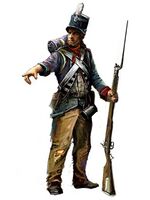
|
LPM(L) 19mm Firearm, LP1720 Field Bayonet | Entrenching Tool, Harness, Cartridge Bandoleer | Infantryman (Inf.) | Infantry of the Line, more commonly referred to as Line Infantry, form the basis of the Royal Army's infantry force. Line Infantry regiments consist of 900 fighting soldiers, divided into six Companies of 150 soldiers each, these in turn are divided into five 'bricks' of thirty men who form up in three ranks of ten. The 'brick' is the basis around which all other formations are created and manoeuvred. The technical term for a 'brick' is a Platoon, however the term is seldom used outside military textbooks and tactical manuals. Each Infantryman carries a standard Long Pattern Musket (Land) and a LP1720 Field Bayonet as their weapons, and are issued a uniform specific to their Regiment, but which will invariably consist of some form of blue long coat and jacket. The minimum requirement for an Infantryman to receive full pay is that they be able to march in good order, maintain their equipment, show discipline, and fire two shots per minute; most regiments however set the informal goal of three shots per minute. Infantrymen go into battle without armour, as most firearms can easily penetrate cheap, mass produced armour. | |
| Rangers | 
|
SPRM(L) 15.7mm Firearm, LP1720 Field Bayonet, LPP 13.7mm Firearm | Entrenching Tool, Harness, Cartridge Bandoleer, Field Kit | Ranger (Rgr.) | Rangers serve as a combination of sharpshooters, reconnaissance, and skirmish infantry. Far less common than Line Infantry regiments, due to the expensive equipment and weaponry they use, the Rangers are often seen as an elite cadre among the infantry regiments of the Royal Army. Structurally Ranger regiments are very similar to Line Infantry regiments, however each 'brick' is subdivided into five six man 'squads', this is an informal arrangement and each 'squad' is typically led by a Sergeant or Corporal under the direction of the Platoon Lieutenant. Rangers move and fight is open formations rather than marching in line, this is due to their role as scouts and sharpshooters, and aids in stealth. Ranger uniforms are typically more hard wearing and practical than Line Infantry uniforms, and tend to have darker colours such as dark blue and dark green to help them blend with their surroundings. Each Ranger carries a Skirmish Pattern Rifled Musket (Land) with LP1720 Field Bayonet, and a Long Pattern Pistol as a sidearm, additionally NCOs are issued with a hatchet or machete. | |
| Skirmishers | 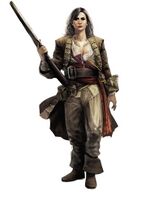
|
LPDM(L) 19mm Firearm or 2 DBLP 13.7mm Firearms, Hatchet, Machete | Harness, Cartridge Bandoleer, Field Kit | Skirmisher (Skr.) | Skirmishers serve as a combination of reconnaissance and skirmish infantry. These regiments provide flanking, screening, and disruption for the main force of Line Infantry and cavalry and are trained to engage in fast moving combat. The most well known use for Skirmishers is in raiding actions against enemy fortifications and artillery positions, however one the battlefield they are more commonly used to screen the main body of the army, and to disrupt enemy troop movements. Skirmisher regiments come in two types, those armed with muskets who are the most common, and those with pistols who are usually used as raiding and close assault troops. There is no standardised uniform requirements for Skirmisher regiments and so each regiment sets its own uniform, though usually these decision are made on the basis of cost and so undyed fabric and khaki tend to be most common. Thanks to the use of double-muskets, and double-pistols Skirmishers are able to sustain fire, however the tactic of keeping a shot in reserve during reloads has also been utilised allowing Skirmishers to surprise enemies who think they must reload with a second shot. | |
| Cavalry of the Royal Army | ||||||
| Hussars | 
|
SPS(L) S1722, One DBLP 13.7mm Firearm | Harness, Cartridge Bandoleer | Cavalryman (Cav.) | Hussars are sabre armed light cavalry who are used for reconnaissance, screening, and pursuit. Since they also carry a double barrelled pistol they also make effective skirmishers. Although trained to serve as charge cavalry also they are rarely employed in this role due to their lack of armour and vulnerability to cannon and musket fire. Hussar uniform consists of a dark blue or black dolman tunic or attila, a pelisse, and crimson breaches. Headgear varies from unit to unit. The quality and style of Hussar uniforms is generally high, giving them their distinctive appearance. | |
| Carbineer | 
|
Two LPDM(L) 19mm Firearms (Short), SPS(N) C1699 | Harness, Cartridge Bandoleer, Steel Breastplate and Helm | Cavalryman (Cav.) | Carbineers are the least glamorous among the cavalry troops of Iblesia. Equipped with a shortened double barrelled musket they fill the roles of reconnaissance, skirmisher, and disruption. Iblesian Carbineers are trained to fire their weapons from horseback at speed and can ride without the use of their arms as a consequence; their accuracy when doing so is questionable however this tactic does cause considerable disruption to enemy infantry formations and artillery crews. Furthermore Iblesian Carbineers are equipped with armour over a plain padded leather uniform so as to better protect themselves from enemy counter charges, and from the volatile nature of the weapons they carry. The typical Iblesian strategy when using Carbineers in a pitched battle is to have them mock charge towards solid enemy formations before wheeling about to fire and then withdraw before the target as a chance to fire an additional musket volley or engage them in close combat. | |
| Pistoleer | Four DBLP 13.7mm Firearms, SPS(N) C1699 | Harness, Cartridge Bandoleer, Steel Breastplate and Helm | Cavalryman (Cav.) | Pistoleers operate in a similar manner to carbineers, except for the use of pistols in place of carbines. Initially intended as a close skirmish formation Pistoleers evolved into a form of heavy cavalry and in addition to their training in skirmish tactics they are also trained to employ shot and charge as well. Despite their reckless and swashbuckling reputation Pistoleers are looked down upon by the Army establishment and are usually issued the same uniforms and equipment as carbineer units. | ||
Royal College of Warmagi
The Royal College of Warmagi, located in Kingsport, is the training college for all magi in military service. The college itself is funded by the Monarch who is also its nominal head, and teaches the various arts of war magic to its students. The entry requirements are rigorous as applicants are expected to show a high level of physical fitness, be of excellent moral character, and highly skilled in the use of magic. Few individuals under the age of twenty five are admitted due to the magic aptitude levels require for acceptance, although exceptions are made in the case of naturally gifted individuals who must be taught control for their own safety. The college was founded in 1654 NIC by royal decree and has produce all of the magi in military service ever since. The principle focus of the college is to teach its students precision and efficiency. Iblesian magical strategy relies upon the careful, concentrated, and precise application of magical ability. The amount of magical energy a person is capable of controlling at once is not considered to be important.
Most graduates of the college are Red Magi, warmagi specialising in the use of magic to conjure and control fire. Red Magi are in regular demand within the Royal Army and new graduates are granted the rank of Cadet-Lieutenant; if they wish to command troops they must then undergo officer training. However Red Magic is not the only art of war magic taught at the college, which has a number of different departments each specialising in a different aspect of war magic. Naturally there is the Department of Red Magic, but there are also Departments for Blue, Yellow, Green, Grey, Black, White, Brown, Clear, Purple, Silver, and Gold Magic (water, electricity, life, shadow, dark, light, earth, mental, air/weather, metal, and time manipulation magic respectively).
History
Prior to the unification of the Isles in 1606 each of the petty kingdoms had their own military forces. Because the only wars being fought were between the island kingdoms these armies and naval forces were never intended for more than island hopping campaigns; as a result naval development and power was focused upon coastal warfare where galleys and lighter vessels predominated, meanwhile land warfare was largely centred around infantry, since cavalry could be difficult to transport over water. While the assorted militaries of the Isles focused upon coastal and island warfare shipbuilding technology did not stagnate entirely; the merchant classes continued to build and develop better ships capable of oceanic voyages, and when armed these vessels often outstripped anything any of the petty kings had in their full time fleet in terms of firepower and durability. This is one of the main reasons why Alexander III turned to merchant shipwrights to design and build ships for his new navy in 1224. Although coastal naval warfare continued to predominate right up until unification in 1606 newer ship designs and better forms of cannon allowed Brytha in particular to develop highly versatile and modern ships.
The armies of the Isles meanwhile focused upon infantry, partly because warhorses were difficult and costly to transport over water, and partly because infantry were capable of fighting just as effectively on board a ship, while making landfall, and when inland. The king of a larger or more fertile island might field a small force of horsemen for defensive purposes, but their utility in this role was limited and the introduction of muskets rapidly brought an end to the conventional armoured cavalry. Despite centuries of constant warfare these infantry forces were not formalised into a professional army until very late in the pre-Unification period; troops were largely raised on a need basis and the standard troop types used were crossbowmen and spearmen - easily trained, cheap to equip, and highly expendable. Elite forces of heavy infantry did exist but were mostly a result of the class system in a feudal society, and with Brytha's ability to produce powerful longbows and later muskets, such heavy infantry fell out of favour.
Perhaps the best example of a late pre-Unification army is that of Gaela, which operated on a tax cut system. The nobility were required to pay additional taxes if they had no standing military force. While in theory this meant that the majority of the soldiers used by Gaela were full time professionals, in practice many nobles maintained a very lightly armed and poorly trained force whose main job was to guard their economic assets. During the final years before Unification, as Brytha was pushing deep into Gaelan territory, this system of 'Tax Armies' was proven to be flawed; Brytha had operated a yeomanry system where a professional army was raised and equipped at the King's expense, and trained to his standards. This simple difference in consistency allowed Brytha to succeed in battle, because Gaelan troops simply couldn't match them for discipline. Even the nobles who had taken the arming and equipping of their troops seriously couldn't stand up to a Brythan army on the field because sections of their line held by other nobles seldom held or fought as well as they did, forcing them to retreat. Although the Gaelans had adopted black powder weapons at the same time as the Brythans they had not realised the need for disciplined formations of musket armed infantry until it was too late.
By contrast the Brythan armies were made up entirely of yeomen. A nobleman might receive a commission to lead a unit in battle and equip them with superior weaponry, but they had to conform to a minimum standard of discipline and equipment function. This meant that regardless of where a regiment was raised, and who led it, a general or commander knew what they could expect from the units available. Cannon were a different matter; although the King maintained a small corps of artillerymen cannon were expensive and the King wasn't willing to pay to raise his own units, therefore it was left to the individual nobles who were under commission to provide artillery support for their troops. This was a major flaw during the final War of Unification which savvy Gaelan commanders exploited; they had fewer cannon, but most were horse drawn, they could manoeuvre far more quickly and target the Brythan batteries, leaving the Brythans without siege weapons.
Traditional & Historic Soldiery
Traditional Brythan armies were centred around light infantry and men-at-arms. The most well known example of traditional Brythan soldiers, and perhaps the type of soldier which was employed for the longest period of time, is the longbowman. Brythan Longbows are usually made from a single piece of yew, and are self bows, carefully cut so that the sapwood forms the rear third of the weapon. The longbow would be widely used by Brythan peasant soldiers for much of the nation's history and until 1612 it was law that all young men aged eleven to thirty had to practice archery at least once a week; as a weapon it surpassed the crossbow in terms of longevity and versatility and provided far greater range and penetration until the development of later siege and heavy crossbows. Only the widespread introduction of black powder weapons caused the longbow to fall out of favour; the increased armour penetration provided by even early firearms such as the arquebus, and the ease of training soldiers to use them made the longbow largely obsolete even though bow armed soldiers could fire more arrows per minute than trained arquebusiers.
Brythan men-at-arms were initially armed with spear and shield, however for a much longer period of time the billhook was employed. The Brythan Billhook was a polearm not dissimilar to a halberd, during times of peace these were used as tools and differed from normal billhooks in that they had a sharp point on the end allowing for them to be used as a spear. Soldiers armed with billhooks were highly versatile, able to counter cavalry, heavy infantry, and regular infantry; however due to how the weapon is used a soldier couldn't be equipped with a shield and a billhook at the same time. Billmen were widely employed by Brytha as a counter to the largely spear equipped infantry and sword equipped cavalry of Gaela; the hook section of the head could be used to push aside polearms or in some cases to break them, and allowed the weapon to remain dangerous as it was drawn back, rather than simply when thrusting. The monarch's ceremonial guards are still armed with billhooks today.
Cavalry played only a minor part in the warfare on the Isles, the nobility generally preferred to fight on foot in heavy armour and fighting on horseback was seen as cowardly as it allowed for rapid flight from the battle. Both the Brythan and Gaelan armies used cavalry for scouting and reconnaissance, however the Gaelans also utilised horse mounted sword and axemen for raiding and hit and run attacks.



